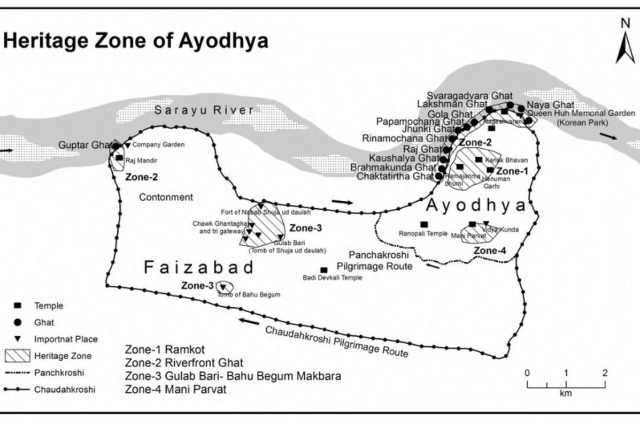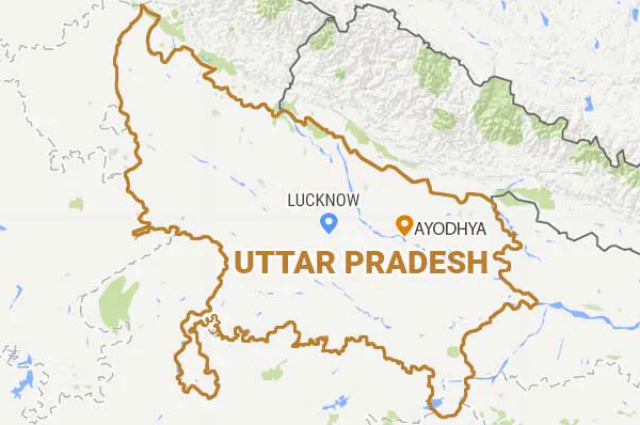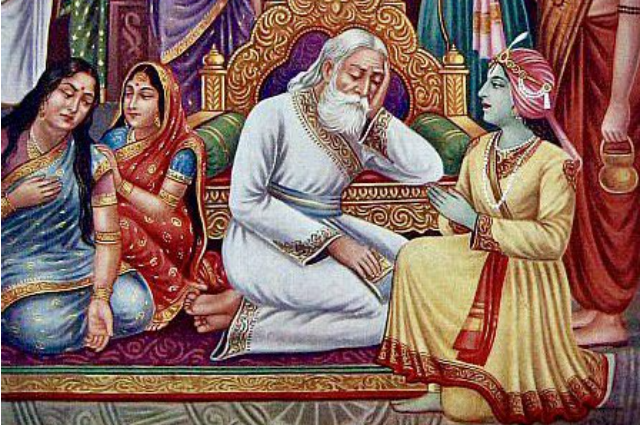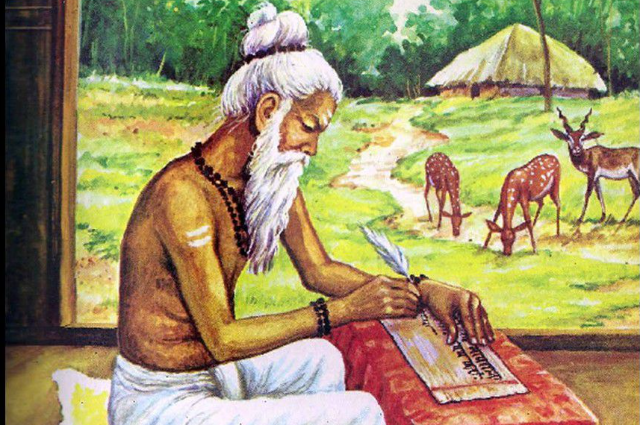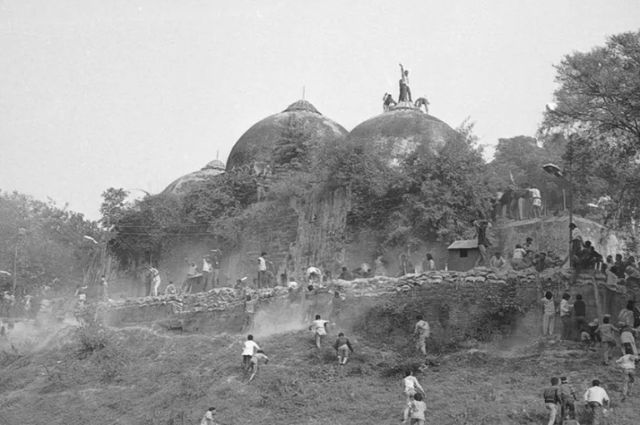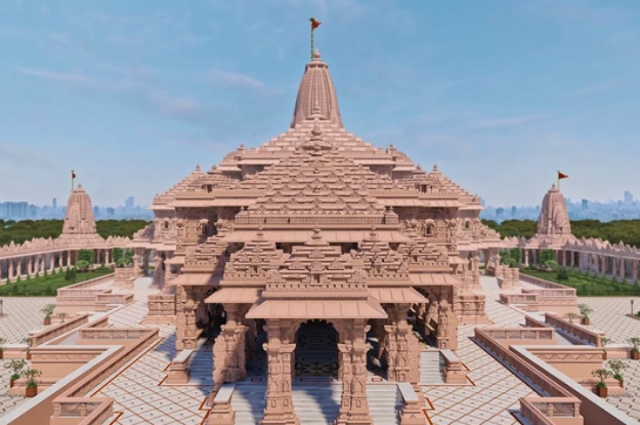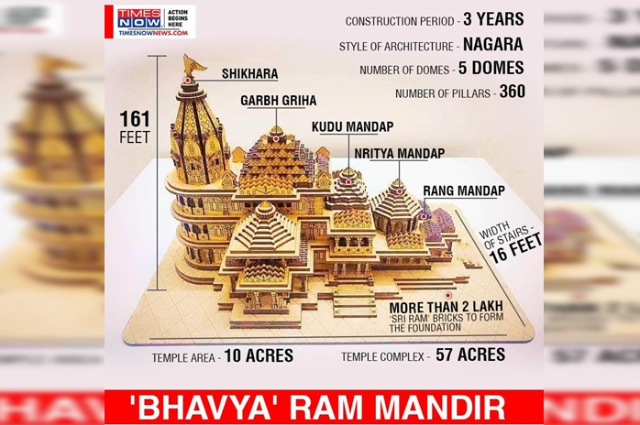In the grand sweep of time, there emerges an extraordinary chapter, a chapter that beckons us to celebrate the triumph of faith, resilience, and the collective spirit that unites us all. After five centuries of anticipation, the resplendent Ram Mandir now stands tall, a symbol of our shared heritage and a testament to the enduring power of unity.
In this moment, irrespective of our diverse backgrounds, we find ourselves enveloped in an overwhelming sense of pride and joy. The inauguration of the Ram Mandir transcends religious and cultural boundaries, becoming a beacon of hope and a source of inspiration for generations to come.
As fortunate witnesses to this historic event, we can't help but swell with pride for being part of a generation that has seen the fruition of a dream cherished for centuries. The collective happiness that courses through our veins knows no distinctions – it is a celebration that unites every heart, transcending caste, religion, and creed. Today, we stand together, proud and jubilant, as witnesses to the realization of a cultural milestone that will forever be etched in the fabric of our shared history.
Let's explore the unfolding history's progression in the form of an article here!
AYODHYA - A Historical Odyssey
Ayodhya's Enigmatic Past
- Sacred Origins: Ayodhya as the Cradle of Kosala - In the annals of time, Ayodhya emerges as the ancient capital of the illustrious Kosala kingdom. A captivating journey back to the Buddhist era (6th–5th century BCE) reveals a shift in power dynamics, as Shravasti takes the throne, becoming the kingdom's principal city. Unraveling the mystery, scholars assert Ayodhya's identity as Saketa, where legend claims the Buddha once dwelled.
- Buddhist Brilliance: Ayodhya's Zenith as a Monastic Haven - In the 5th century CE, Chinese Buddhist monk Faxian paints a vivid picture of Ayodhya's prominence. A staggering claim of 100 monasteries adorning the city attests to its zenith as a Buddhist center. Beyond mere numbers, Ayodhya boasted monumental structures, including a stupa believed to be the legacy of the great Mauryan emperor Ashoka (3rd century BCE).
Ayodhya's Renaissance
- 11th and 12th Centuries CE: Ayodhya's Transformation into Kanauj - Witnessing a dynamic metamorphosis, Ayodhya transforms during the 11th and 12th centuries CE into the thriving Kanauj kingdom. This era, marked by cultural and political dynamism, sets the stage for Ayodhya's role in subsequent imperial transitions.
- Imperial Echoes: Delhi Sultanate, Jaunpur Kingdom, and the Mughal Tapestry - Ayodhya's saga intertwines with imperial narratives, as it becomes a vassal to the Delhi Sultanate and the Jaunpur kingdom. The 16th century heralds a new chapter, with the city finding its place within the illustrious Mughal Empire.
Ayodhya's Journey through Colonial Turbulence
- 18th Century Autonomy: Ayodhya's Struggle and Subjugation - In the early 18th century, Ayodhya experiences a fleeting sense of autonomy. However, the looming shadow of the British East India Company in 1764 marks the beginning of a new chapter, where Ayodhya becomes a subordinate entity.
- 1856: British Annexation and the Spark of Rebellion - A pivotal year in Ayodhya's history, 1856 witnesses British annexation. The ensuing loss of rights for hereditary land revenue receivers becomes a flashpoint, fueling the flames of the Indian Mutiny in 1857.
Ayodhya's Integration: The Birth of Uttar Pradesh
- 1877 Merger: Ayodhya and Agra Presidency Unite - In a historical merger, Ayodhya joins forces with the Agra Presidency in 1877. This union becomes the foundation for the creation of the United Provinces of Agra and Oudh, a precursor to the modern-day state of Uttar Pradesh. Ayodhya's journey, marked by sacred origins, imperial echoes, and colonial turbulence, weaves a tapestry that continues to captivate the imagination of historians and enthusiasts alike.
SHRI RAM
Divine Birth of Shri Rama
In the revered era of Treta Yuga, a celestial plan was set in motion. Lord Vishnu, the cosmic preserver, chose to manifest on earth in his eighth incarnation. His birth took place in the royal palace of King Dashrath in Ayodhya, now sanctified as Ram Janmabhoomi. The divine infant, named Rama, emerged as the firstborn to Queen Kaushalya. This avatar served as a trial of endurance for Lord Vishnu, navigating the challenges of mortal existence while upholding the highest principles of righteousness. Today, spanning centuries, the life and teachings of Shri Rama, revered as Maryada Purushottam, continue to serve as a guiding light, inspiring millions across the globe.
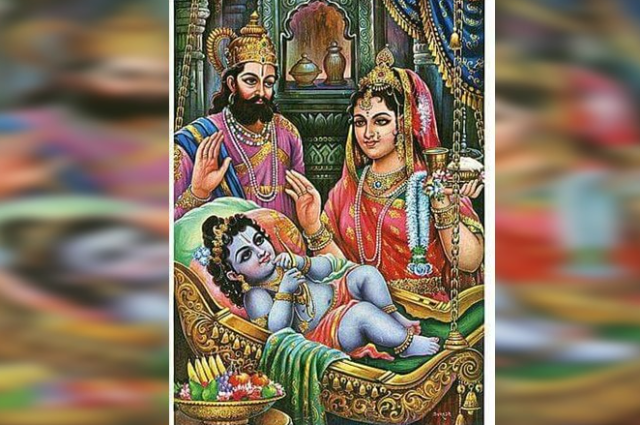
King Dashrath’s Quest for an Heir
King Dashrath, a formidable warrior hailing from the esteemed Suryavanshi Ikshavaku dynasty, was celebrated for both his might and widespread acclaim. Despite having three queens—Kaushalya, Sumitra, and Kaikeyi—he found himself grappling with the poignant predicament of childlessness. The absence of an heir cast a profound shadow upon his heart, prompting him to seek guidance. Turning to his family guru, the venerable Sage Vashishth, Dashrath poured out his distress. In response, Sage Vashishth, perceiving the depth of the king's concern, counseled him to undertake the Putrakameshti Yagya, with the revered Sage Shringa Muni overseeing the auspicious ritual.
The Divine Ritual and Blessing
With steadfast faith, King Dashrath orchestrated the Yagya, extending a heartfelt invitation to Sage Shringa Muni to preside over the sacred ritual. As the ceremonious proceedings reached their culmination, Agni Dev, the Fire God, manifested from the consecrated fire pit. Cradling a bowl brimming with a celestial sweet concoction, a manifestation of Dashrath's unwavering devotion, the Fire God presented it to the king. With solemn instructions, Agni Dev guided Dashrath to distribute this divine offering among his three queens.
The Birth of Shri Rama and His Brothers
Upon receiving the divine blessing, Dashrath extended the celestial sweet first to Kaushalya, followed by Kaikeyi and Sumitra. In accordance with the sacred timing, on the auspicious Navami Tithi of the Shukla Paksha in the Chaitra month, each queen experienced the joyous fulfillment of motherhood. Kaushalya welcomed Shri Rama into the world, Kaikeyi was blessed with Bharat, and Sumitra, having consumed a double portion of the divine sweet, joyously gave birth to twin sons - Lakshman and Shatrughan.
This divine orchestration unfolded seamlessly, heralding the advent of Lord Rama on the earthly realm - an epochal occurrence that resonates with vibrant celebrations to this very day.
RAMAYANA - The Evidence
Sage Valmiki's Magnum Opus
Traditionally attributed to the sage Valmiki, the Ramayana stands as an ancient Indian epic and one of the two major Sanskrit epics, alongside the Mahabharata. Valmiki is venerated as the Adi Kavi (first poet) and is credited with composing this extraordinary narrative.
The Epic Narrative
The Ramayana, an expansive and timeless saga, intricately weaves the tapestry of virtue, duty, and heroism. At its core is the life of Prince Rama, an avatar of Lord Vishnu, who embarks on a profound journey. Accompanied by his devoted wife Sita and unwavering ally Hanuman, Rama's life unfolds as a testament to righteousness, dharma, and the eternal battle between good and evil.
Overview of the Themes Explored:
- Struggle Between Good and Evil: The Ramayana serves as a profound exploration of the eternal battle between righteousness (dharma) and malevolence (adharma). Rama, the embodiment of virtue, confronts the demon king Ravana, symbolizing the forces of darkness.
- Moral and Ethical Dilemmas: The epic delves into complex moral and ethical dilemmas faced by its characters, providing profound insights into the intricacies of human existence.
- Love, Devotion, and Loyalty: The narrative unfolds richly in themes of love and devotion, exemplified by Rama's unwavering commitment to his wife Sita, and the unparalleled loyalty of Hanuman.
The Ramayana's Journey Beyond Borders
The Ramayana's journey beyond Indian borders began through trade routes, both land and sea. Indian traders, carrying not just goods but also cultural narratives, spread the epic to China, Tibet, Burma, Thailand, and Laos through land routes and to Java, Sumatra, and Malaya via sea routes.
Cultural Transmission by Indian Communities
Indian traders, accompanied by scholars and spiritual leaders, played a pivotal role in disseminating Indian culture to Southeast Asia. The Ramayana, over time, became an integral part of the cultural tapestry of these regions, influencing art, architecture, and religious practices.
Integration into Local Culture
The Ramayana seamlessly integrated with local cultures across Southeast Asia. In Thailand, the Ayutthaya kingdom's foundations are believed to mirror the Ayodhya of the Ramayana, while in Cambodia, the Angkor Wat temple complex showcases murals depicting scenes from the epic.
Evolution of the Epic
Adaptations of the Ramayana in different countries took on unique elements, such as the Thai Ramakien, influenced by the Tamil epic Kamban Ramayana, becoming Thailand's national epic. The diversity in adaptations reflects the dynamic nature of the epic as it blended with local traditions.
Spread Through Indentured Labor Migration
The 19th-century Girmitiya Migration played a crucial role in spreading the Ramayana to Fiji, Mauritius, Trinidad and Tobago, Guyana, and Suriname. Indentured laborers carried not just their labor but also their cultural and religious practices, including the Ramcharitmanas, to new lands.
Enduring Themes and Universality
The Ramayana served as a source of cultural identity for Indian communities dispersed across the globe. Its universal themes of good prevailing over evil, adherence to dharma, and the narrative of exile and return resonated with diverse cultures, providing a sense of connection and familiarity.
Continued Cultural Practices
Even today, the Ramayana remains a significant cultural force in many Southeast Asian countries. Its enduring influence is manifested through various art forms, including plays, dance dramas, puppet shows, and religious ceremonies, keeping the epic alive and vibrant in the hearts of people.
The Ayodhya Saga - A Chronicle of Faith, Conflict, and Resolution
While the Ramayana delves into the sacred connection between Rama and Ayodhya, the Ayodhya saga in history involves the Babri Masjid-Ram Janmabhoomi dispute, becoming a source of historical and religious contention in India. This dispute unfolded over centuries and culminated in the construction of the Ram Temple in Ayodhya, marking the end of a longstanding and tumultuous chapter in India's history.
The Birth of Babri Masjid (1528)
In the heart of Ayodhya, a mosque known as the Babri Masjid was erected in September 1529, under the directive of Babur, the inaugural Mughal Emperor. This mosque is believed to be one of three built in the 16th century on Babur’s command, with the other two located in Panipat and Sambhal.
The Communal Clash and the Fence (1856-1857)
The site of the mosque is revered by Hindus as the birthplace of Lord Shri Ram. In 1856-1857, communal tensions escalated into a riot. The Babri Masjid and the nearby Hanuman Garhi temple became the epicentres of the conflict. The aftermath saw the construction of a grill-brick wall outside the mosque, known as the Ram Chabutra, which served as a worship site for Hindus.
The Legal Battle Begins (1885)
In January 1885, Mahant Raghubar Das, the head priest of the Ram Chabutra, filed a lawsuit seeking permission to construct a temple in the mosque’s outer courtyard. The lawsuit, along with two subsequent appeals, was dismissed. The District Judge and Judicial Commissioner stated that there was no evidence to prove that the plaintiff owned the land.
Communal Riots Erupt Again (1934)
On 27 March 1934, communal riots broke out in Ayodhya, causing significant damage to the mosque’s domes. The British Government funded the repairs, and a fine was imposed on the Bairagis, the Vaishnavite Hindu priests, and the Hindu community rioters to recover the repair costs.
The Appearance of the Ram Idol (December 1949)
On the night of 22 December 1949, an idol of Ram mysteriously appeared in the sanctum of the Babri Masjid. Hindus interpreted this as a divine revelation, while Muslims argued that the idol had been smuggled in and placed there. The prime suspect was identified as Baba Abhiram Das, a local sadhu. On 23 December 1949, the City Magistrate of Faizabad and Ayodhya declared an emergency under Section 144 of the Code of Criminal Procedure, 1898. This was followed by a Section 145 order by the Additional City Magistrate attaching the disputed site.
The site was placed under the receivership of the Chairman of the Municipal Board, Priya Datt Ram. The mosque’s gates were locked, effectively stopping Muslim prayers in the area. (In its 2019 judgement, the Supreme Court accepted the Allahabad High Court’s findings that the idols had been deliberately placed inside the mosque.)
Hindu Sides File Suits; Allahabad HC Dismisses Appeal (1950)
Two suits were filed in the Faizabad court by Gopal Singh Visharad and Paramhans Ramchandra Das. They alleged that government officials were preventing them from entering the inner courtyard of the disputed site for worship. On the same day, an ad-interim injunction was passed in Visharad’s suit to maintain the status quo and continue sewa-puja. On 19 January 1950, the injunction was modified to prevent the idols from being removed from the disputed site and from causing interference in the performance of puja. This injunction was confirmed by a trial court in March 1951. On 26 May 1955, the Allahabad High Court dismissed appeals against this order.
Third Hindu Suit Filed (1959)
On 17 December 1959, Nirmohi Akhara, a Hindu sect, filed a third suit before the Civil Judge at Faizabad. The suit claimed that Akhara had the absolute right to manage the affairs of the Janmasthan (birthplace).
Sunni Central Waqf Board Files a Suit (1961)
On 18 December 1961, the Sunni Central Waqf Board and nine Muslim residents of Ayodhya filed a suit before the Civil Judge at Faizabad. Their ask—a judicial declaration stating that the entire disputed site of the Babri Masjid was a public mosque. They made two more requests of the court: (a) deliver possession of the disputed land; and (b) direct the removal of the idols in the mosque.
Ram Janmabhoomi Movement Commences (1984)
Vishwa Hindu Parishad (VHP) constituted a group to start the Ram Janmabhoomi Movement. The goal was the construction of a Ram temple at the site. BJP leader L.K. Advani was made the leader of the campaign. In 1989, PM Rajiv Gandhi allowed the VHP to perform Shilanyas (laying of the foundation stone for the temple) near the disputed area.
The Inner Gate of Babri Mosque Opened (1986)
On 25 January 1986, lawyer Umesh Chandra Pandey appealed before the Faizabad Session Court for the gates to be unlocked. Meanwhile, in a reportedly political move to allay the Hindu dissatisfaction over the reversal of Shah Bano's judgement by the government, then PM Rajiv Gandhi decided to greenlight the mosque’s unlocking. On 1 February, the District Judge ordered the locks to be removed to allow Hindu “pooja and darshan”. Subsequently, a writ petition was filed before the High Court challenging the 1 February Order. An interim order was passed on 3 February directing the nature of the property not to be altered until further orders. Muslims constituted a Babri Mosque Action Committee (BMAC) in protest.
All Title Suits Shift to Allahabad High Court (1989)
Another suit was filed in 1989 on behalf of the deity, Bhagwan Shri Ram Virajman and the birthplace of Lord Ram, Asthan Shri Ram Janmabhumi. The premise of the suit was that the law recognises both the idol and the birthplace as juridical entities. On 10 July 1989, all suits were shifted to the Allahabad High Court. A three-judge bench was formed on 21 July 1989 to hear the case. Following a request from the Uttar Pradesh government, the High Court issued an interim order on 14 August 1989 to maintain the status quo at the disputed site. The state acquired 2.77 acres around the disputed area through notifications on 7 and 10 October 1991 under the Land Acquisition Act 1894.
The Rath Yatra (25 September 1990)
L.K. Advani launches a Rath Yatra from Somnath (Gujarat) to Ayodhya to drum up support for the movement. Communal riots break out across the country.
Babri Mosque Vandalised (6 December 1992)
Babri Mosque was razed by a mob of Karsevaks (religious volunteers). The mosque, boundary wall and Ram Chabutra were destroyed. The Karsevaks left behind a makeshift temple in its place.
Liberhan Commission Formed (16 December 1992)
Ten days after the mosque was demolished, the Narasimha Rao government formed a committee led by retired High Court Justice M. S. Liberhan, to look into the circumstances leading to the demolition of the Babri Masjid and the ensuing communal riots across the country. The Commission was originally mandated to submit its report within three months of its formation. (The Commission submitted its report to Prime Minister Manmohan Singh on 30 June 2009).
State Acquires Ayodhya Land (7 January 1993)
Narasimha Rao's government issues an ordinance acquiring 67.7 acres of land ( adjoining the site). The ordinance was then converted into an Act titled Acquisition of Certain Areas at Ayodhya Act, 1993. One of the objectives of the Act was to “maintain public order and to promote communal harmony and the spirit of common brotherhood amongst the people of India.” A petition challenging this Act was filed at the Supreme Court.
Ismail Faruqui Judgment (1994)
The Supreme Court, by a majority of 3:2, upheld the constitutionality of the Acquisition of Certain Areas at Ayodhya Act. The majority judgement, authored by then CJI J.S. Verma reasoned that every religious immovable property is liable to be acquired. The Court also held that offering namaz at a mosque was not integral to Islam unless that mosque had any particular significance in Islam.
Allahabad High Court Orders Archaeological Survey (2002)
On 24 July 1996, the Lucknow Bench of the Allahabad High Court began recording the oral evidence in the Ayodhya title dispute. During the hearings, the High Court issued directions on 23 October 2002 to the Archaeological Survey of India (ASI). ASI was tasked with carrying out a scientific investigation and surveying the disputed site with Ground Penetrating Technology or Geo-Radiology.
ASI Survey (March–August 2003)
- Led by the Visionary BR Mani: In a quest to unearth the mysteries buried beneath the sacred soil of Ayodhya, the Archaeological Survey of India (ASI), under the guidance of the eminent archaeologist BR Mani, embarked on an extraordinary archaeological expedition. Their mission? To delve into the layers of time, employing state-of-the-art Ground-Penetrating Radar (GPR) technology, peeling back the layers that concealed Ayodhya's intricate history.
- Chronicle of Excavations (2003): The archaeological odyssey faced a barrage of challenges as the ASI team descended upon the hallowed grounds once occupied by the Babri Masjid. The excavation site buzzed with a symphony of activity, involving not just archaeologists but also security personnel, laborers, and representatives of the 25 parties entangled in the court litigation. Undeterred by the complexity of the landscape, the ASI meticulously laid out 90 trenches, each measuring 5x5 meters, orchestrating a dance with history itself.
- Unveiling Layers of Time - From 17th Century BCE to Present: As the trenches deepened, an awe-inspiring panorama of Ayodhya's history unfolded. The meticulous excavation revealed artifacts spanning the late Mughal era, the Gupta period, the Kushan dynasty, and even reaching back to the Mauryan period, an astonishing 1680 BCE. This revelation not only reshaped the historical narrative but pushed back the origins of the Janmabhoomi site by a staggering millennium.
- ASI's Magnum Opus - The 2003 Report: In the heart of the excavation lay the ASI's magnum opus - the 2003 report. A meticulous analysis of 47 pillar bases and an east-facing circular shrine provided a concrete link to a temple-like structure beneath the Babri Masjid. This monumental discovery would play a pivotal role in the subsequent legal discourse, culminating in the Supreme Court's 2019 judgment that acknowledged these findings while skirting the definitive assertion of intentional demolition.
- Metamorphosis of Ayodhya - A Transition in Time: Beyond the physical structures, the unearthed evidence hinted at a metamorphosis in the nature of the Ayodhya site. Originating as a habitational site until the 4th Century AD, the transition to a religious site became apparent with the discovery of grand structures from the Gupta period. The evolution continued, revealing evidence of three distinct temples from the 9th to the 13th Century.
- Echoes of BB Lal's Premonitions (1976-77): The echoes of Ayodhya's past resonated with the findings of BB Lal in 1976-77. Lal's early research on the 'Archaeology of the Ramayana Sites' laid the groundwork for subsequent excavations, providing prescient hints of a temple lying beneath the shadows of the Babri Masjid.
- Babur's Role and the Missing Pages of Baburnama: The historical puzzle deepened with the narrative of Babur's role in the Babri Masjid's construction. Intriguing questions emerged, amplified by the missing pages in Baburnama during the critical period of the mosque's construction. This enigma added layers of complexity to the circumstances surrounding the temple's demise.
- ASI Report's Enigma - Unanswered Queries: The ASI's report, a treasure trove of evidence, raised more questions than answers. BR Mani clarified that the ASI's role was confined to presenting the evidence, not interpreting it. This nuanced stance left ample room for speculation, fostering an environment of perpetual debate.
- Post-Demolition Revelations - The Vishnu-Hari Inscription: In the aftermath of the mosque's demolition, a compelling revelation emerged - a 12th Century Vishnu-Hari inscription. This inscribed relic not only affirmed the site's association with Lord Ram but also hinted at the repurposing of temple elements in the construction of the mosque.
- Controversies and Personal Turmoil: Amidst the dust of excavations, the archaeologists, BR Mani and KK Muhammed, found themselves thrust into controversies and subjected to personal attacks. The Ayodhya debate, already laden with historical complexities, spilled over into the personal lives of those unraveling its secrets.
- Urgent Call for Transparency - Unveiling the ASI's Report: The controversies, diverse interpretations, and lingering uncertainties underscored the urgent need for transparency. Calls persist for making the ASI's 2003 excavation report public, inviting scholars and the public alike to scrutinize the findings and contribute to a more nuanced understanding of Ayodhya's intricate tapestry.
Allahabad High Court Verdict (30 September 2010)
The High Court held in a split 2:1 verdict that the Hindu and Muslim parties were joint holders of the disputed premises. One-third of the disputed property was allocated to the three parties—Bhagwan Shri Ram Virajman, the Sunni Wakf Board and the Nirmohi Akhara.
The Legal Tug of War (May 2011)
In a surprising turn of events, the Supreme Court of India, led by a Division Bench comprising Justices Aftab Alam and R.M. Lodha, put a stay on the verdict of the Allahabad High Court regarding the Ayodhya dispute on 9 May 2011. The Bench found the High Court’s judgement peculiar, with Justice Lodha remarking on the unusual nature of the partition decree, given that none of the parties involved had requested it.
A Call for Resolution (21 March 2017)
Former Chief Justice J.S. Khehar suggested that all parties involved in the dispute should attempt an out-of-court settlement, marking a significant moment in the ongoing legal battle.
The Supreme Court Steps In (11 August 2017)
A Bench comprising Chief Justice Dipak Misra, Justice Ashok Bhushan, and Justice Abdul Nazeer began hearing the appeal on the Ayodhya dispute. On 5 December 2017, the Bench decided against referring the case to a larger Bench.
Revisiting Past Judgements (2018)
In 2018, the three-judge bench of the Supreme Court heard arguments on whether the judgement in the Ismail Faruqui case required reconsideration. However, on 27 September 2018, the Bench, by a majority of 2:1, declined to refer Ismail Faruqui for reconsideration.
Constitution Bench Takes Charge (8 January 2019)
Chief Justice Rajan Gogoi exercised his administrative powers to list the matter before a five-judge Constitution Bench. The Bench included the CJI along with Justices S.A. Bobde, N.V. Ramana, U.U. Lalit, and D.Y. Chandrachud. After Justice Lalit recused himself on 10 January, Justice Abdul Nazeer was drafted in his place.
Mediation Efforts Initiated (February 2019)
On 26 February 2019, the Supreme Court referred the parties to mediation. The panel appointed on 8 March 2019 included former Justice Fakkir Mohamed Ibrahim Kalifulla, spiritual leader Sri Sri Ravi Shankar, and Senior Advocate Sriram Panchu.
Mediation Fails, Hearings Resume (6 August 2019)
The parties failed to reach a comprehensive settlement, leading the Supreme Court to resume hearings on the dispute on 6 August 2019. A mediation report submitted on 16 October 2019 indicated a partial settlement, but it was not binding as it wasn’t agreed upon by all disputants.
A Landmark Judgement (November 2019)
On 9 November 2019, the apex court delivered its judgement. It awarded the title to the deity, Shri Ram Virajman, and directed the State to grant the Sunni Waqf Board five acres in a “prominent” location in Ayodhya for the construction of a mosque.
Laying the Foundation (August 2020)
On 5 August 2020, Prime Minister Narendra Modi laid the foundation stone for the proposed Ram Temple in Ayodhya, marking a significant milestone in the Ayodhya saga.
The Grand Inauguration (22 January 2024)
In a grand ceremony reportedly attended by over 7000 people, the Ram Temple at Ayodhya was inaugurated on 22 January 2024. Prime Minister Narendra Modi performed the ‘Pran Pratistha’ ceremony, signifying the end of a long and tumultuous journey.
Architectural Marvel of Ram Mandhir - The Unique Charms of the Ram Temple
Traditional Splendor and Construction
In the heartland of Ayodhya, the Ram Temple rises in regal glory, a testament to the resplendent Nagara style. Constructed with rose-hued sandstone sourced from Mirzapur and the Bansi-Paharpur hills in Rajasthan, this three-storey sanctum spans an expansive 71 acres, a symphony of traditional artistry.
Architect:
The visionary behind the temple's design is Chandrakant Bhai Sompura, the esteemed architect known for his role in creating the Akshardham temple in Gujarat.
Ram Mandir Temple Dimensions:
Behold the colossal dimensions! At 250 feet in width and 161 feet in height, the main temple area covers 2.67 acres. Adorned with 390 pillars, 46 doorways, and 5 mandaps, this architectural masterpiece is a canvas of divine proportions.
Mandapas and Temple Structure:
Within the sacred confines of the temple, five mandapas grace the middle of the garbhagriha and the entrance, creating a divine ambiance. The heart of the sanctum is adorned by the presence of Ram Lalla Virajman, the divine infant manifestation of Lord Rama and an incarnation of Lord Vishnu.
Diverse Deities and Idol Ensemble:
The temple's spiritual tapestry unfolds with various idols, encompassing the incarnations of Shiva, the 10 Dashavataras, the 64 Chausath Yoginis, and the 12 manifestations of the goddess Saraswati, each contributing to the rich symbolism within.
Architectural Brilliance:
Elevating the temple's grandeur, the main structure rises from a raised platform, soaring to three impressive storeys. The integration of modern and traditional techniques is evident in the meticulously crafted 360 pillars, all hewn from stone.
Technical Expertise from IIT Chennai:
The construction of this monumental structure has been guided by the expertise of IIT Chennai, ensuring a harmonious blend of architectural excellence and structural integrity.
Engineering Marvel by Larsen and Toubro:
The hands of Larsen and Toubro, wielding skill and precision, have brought this architectural wonder to life. Merging modern engineering with traditional craftsmanship, the temple stands as a testament to the prowess of its builders.
Resilience in the Face of Nature:
With an unwavering commitment to withstand nature's forces, the temple is a marvel of modern engineering. Its design, crafted to endure the most formidable earthquakes and intense floods, reflects a fusion of technological innovation and a deep reverence for the sanctity of the temple.
Guiding Management by Tata Consulting Engineers Limited:
Under the astute management of Tata Consulting Engineers Limited, the construction of the temple unfolds seamlessly. Their leadership ensures that the project adheres to the highest standards of quality and execution, contributing to the overall success of this sacred endeavor.
Intricate Sanctum:
Venture inside to discover the main Garbh Griha, cradling the idols of Ram Lalla. It's a spiritual voyage through multiple mandaps, including the enchanting Rang Mandap and Nritya Mandap, where devotion meets artistry.
Solar Symphony - Innovative Anointment:
On every Ram Navami, witness an ingenious ritual unfold. Mirrors and lenses dance in perfect harmony, focusing the sun's rays on Ram Lalla's idol. This unique anointment, devoid of electricity and crafted with brass, weaves tradition and innovation into a mesmerizing spectacle.
Artistry by Arun Yogiraj:
The central idol, a divine rendition of five-year-old Ram Lalla, stands at 51 inches, sculpted with precision by the skilled hands of Mysuru's Arun Yogiraj. Consecrated in a ceremony that mirrored the sanctity of the temple, this idol is a testament to the sculptor's devotion.
Durability and Symbolism:
A striking feature of the temple's construction lies in its endurance. No iron was employed in its creation, a deliberate choice to ensure it stands tall for at least a millennium. Symbolizing strength and timeless devotion, it stands as a beacon of architectural excellence.
Decoding the Nagara Style: A Journey Through Time and Form
Historical Tapestry:
Delve into the roots of Nagara architecture, emerging like a phoenix in the 5th century CE during the Gupta period in northern India. A style in contrast to the Dravida of the south, Nagara temples stand as timeless symbols of divinity.
Towering Shikhara - Architectural Symphony:
The distinguishing feature of Nagara temples is the towering Shikhara. Built on a raised plinth, with the Garbha Griha as the sacred core, the Shikhara stands tall, echoing the natural and cosmological order of Hindu tradition.
Five Modes of Nagara Architecture:
Valabhi: This mode, inspired by chaitya halls, formalizes multi-eave towers and showcases a piling up of slabs. It is a testament to the evolution of temple architecture.
- Phamsana: Characterized by a formalized shikhara and a progression from the Valabhi mode, Phamsana represents the Early Nagara Style, highlighting the evolution of architectural forms.
- Latina: Featuring a single, slightly curved tower with equal sides, the Latina mode, at its peak during the Gupta era, spread across northern India, leaving a lasting impact on Nagara temple architecture.
- Shekhari: The Shekhari mode introduces attached sub-spires or spirelets, echoing the main shikhara's shape. This innovation adds intricate details to the temple's facade.
- Bhumija: The Bhumija mode, emerging in the tenth century, incorporates miniature spires arranged in a grid-like fashion, showcasing a pyramidal shape. This style showcases the continuous evolution and creativity in Nagara architecture.
Overview of Ayodhya Ram Mandir Inauguration: Pran Pratishtha Ceremony
Unveiling of Ram Lalla Idol
- The Pran Pratishtha ceremony held at the revered Ram Janmabhoomi Temple witnessed the ceremonial unveiling of the idol of Ram Lalla.
- Key figures such as Prime Minister Narendra Modi, RSS chief Mohan Bhagwat, and Uttar Pradesh CM Yogi Adityanath actively participated in this significant event.
PM Modi's Leading Role in Rituals
- Dressed in an opulent golden kurta and cream-colored dhoti, Prime Minister Modi played a central role in performing the intricate rituals.
- The Prime Minister initiated the ceremony with the 'sankalp,' symbolizing a deep commitment to the consecration process.
Message from PM Modi
- Prior to the ceremony, Prime Minister Modi shared his anticipation, expressing that the consecration of Shri Ram Lalla's life in Ayodhya Dham would evoke profound emotions.
- In his post-ceremony address, PM Modi highlighted the all-encompassing nature of Lord Ram, declaring, "Today, our Ram has arrived," and expressed gratitude for being part of this divine occasion.
Unveiling of 'Jatayu' Statue
- PM Modi's visit extended to the Kuber Tila on the temple premises, where he conducted a 'jalabhishek' and unveiled a statue of 'Jatayu,' a mythical bird from the Ramayana.
- As a gesture of appreciation, PM Modi showered flower petals on the diligent workers involved in the construction of the Ram Temple.
'Mangal Dhwani' Musical Extravaganza
- A remarkable feature of the ceremony was the devotional "Mangal Dhwani," a musical spectacle featuring 50 traditional instruments from diverse regions of India.
- Orchestrated by Ayodhya's celebrated poet Yatindra Mishra, the grand musical performance resonated with hymns, verses, and songs dedicated to Lord Ram.
Star-Studded event
- The ceremony attracted a distinguished gathering of over 8,000 guests, transforming it into a star-studded event in Ayodhya.
- Eminent personalities from various sectors, including politicians and Bollywood stars like Vicky Kaushal, Ranbir Kapoor, Alia Bhatt, along with business magnates such as Mukesh Ambani, graced the occasion.
Nepal Minister's Expression of Gratitude
- Nepal's Union Minister Sarat Singh Bhandari conveyed appreciation, declaring that the world has entered the era of Ram.
- A notable 25-foot-tall mural of Ram and Sita was unveiled in Mahottari, symbolizing the significance of the Pran Pratishtha ceremony.
Controversy Surrounding Telecast Ban
- The Supreme Court addressed the controversy surrounding the ban on telecasting the ceremony in Tamil Nadu.
- Emphasizing the importance of adherence to the law, the court clarified that actions should be based on legal guidelines rather than oral instructions.
Rahul Gandhi's Temple Visit Episode
- Dramatic events unfolded in Assam as Congress leader Rahul Gandhi encountered initial resistance in visiting the Sri Sri Sankar Dev Satra temple.
- Gandhi questioned the authorities, raising concerns about interference in temple visits and advocating for leaders to have the autonomy to decide when and where they can visit temples.
Celebrations by Opposition Leaders
- In Delhi, Chief Minister Arvind Kejriwal and AAP organized shobha yatras and 'Sundar Kand' recitals to commemorate the Pran Pratistha ceremony.
- West Bengal CM Mamata Banerjee led an all-faith harmony rally in Kolkata, initiating the 'Sanghati March' after offering prayers at the Kalighat temple.
- Former MP CM Kamal Nath extended greetings and prayers for the nation's prosperity, emphasizing the construction of the Ram Temple in accordance with the Supreme Court's directives.
- The Pran Pratishtha ceremony marked a historic and culturally rich event, bringing together religious fervor, political leadership, and a spirit of celebration in Ayodhya.
Conclusion
Ascending from the ancient soil of Ayodhya, the Ram Mandir unveils a saga of faith etched in stone and sanctity. As the sacred spires kiss the sky, they echo not just the culmination of architectural finesse but the spirit of a resurgent culture. The grandeur of the ceremony, with its distinguished guests led by Prime Minister Narendra Modi, reverberated the essence of unity, diversity, and shared heritage. As we celebrate this architectural marvel, let us remember the words of Mahatma Gandhi, 'A nation's culture resides in the hearts and in the soul of its people.' In this harmonious existence, the Ram Mandir stands not just as bricks and mortar but as a beacon of collective aspirations and shared dreams.
. . .
References:
- https://www.aljazeera.com/news
- https://www.livemint.com/news/
- https://economictimes.indiatimes.com/news/
- https://www.indiatoday.in/india/
- https://aninews.in/
- https://www.bbc.com/news/
- https://indianexpress.com/
- https://www.ndtv.com/india-news

